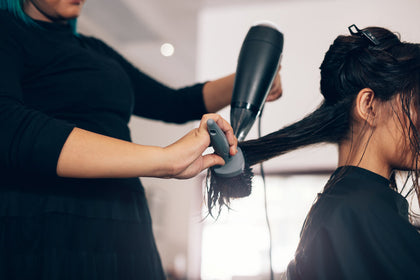The allure of a Brazilian Blowout is easy to understand. Salons offering the treatment tout the Brazilian as a one-stop answer to transform any hair type into smooth, silky hair. But there's a hidden dark side to this popular hair smoothing treatment. The Food and Drug Administration warns that Brazilian Blowout formulas and other similar chemical hair straightening products can release chemicals damaging to your health, the health of your hair and the health of the salon employees as well.
Before you book that salon treatment, here's a breakdown of the potential dangers of this hair treatment, as well as some cheaper and healthier keratin alternatives for getting smooth, silky hair.
#include-related-slider#
The Strange History of the Brazilian Blowout
The Brazilian Blowout got its start in Brazil (as you might have guessed) in 2005. At the time, super straight, glossy hair was the height of fashion. And in a country where high levels of humidity make it difficult for hair straighteners to tame curls, the Brazilian Blowout treatment caught on immediately, quickly spreading to the United States.
But what users didn't know is that the hair straightening treatment wasn't designed by a stylist or other hair care professional. It was invented by a mortician who noticed that the formaldehyde used in embalming caused hair to straighten. And so, the Brazilian Blowout hair treatment was born.
Shop: Best Selling Hair Products
What Is a Brazilian Blowout and How Does It Work?
A Brazilian Blowout treatment starts with a liquid keratin formula, which coats each individual strand of the treated hair to create a protective barrier and produces a smoothing effect. Keratin treatments can help strengthen and smooth your hair strands, temporarily giving your hair a glossy, fuller appearance.
Keratin treatments are based on a type of protein naturally present in human hair, skin, nails and even teeth. The keratin used in a Brazilian Blowout is typically sourced from the hooves and nails of animals and birds, making it a no-go for vegans. The blowout formula often also contains natural ingredients sourced from Brazil, such as acai berry, annatto seed and camu camu.
However, binding ingredients are necessary to attach the keratin treatment to the hair strand, and this is where the potential Brazilian Blowout dangers begin. Most Brazilian Blowout formulas contain formaldehyde. The hair smoothing ingredients in a Brazilian Blowout may also include potentially dangerous chemicals such as:
- Formaldehyde
- Methylene glycol
- Oxide Paraform Formic Aldehyde
- Formic aldehyde
- CAS No. 50-00-0
- Formalin
- Methylene Oxide Paraform Formic
- Oxymethylene
- Methylene oxide
- Timonacic acid
- Paraform
- Oxomethane
- Methanol
- Various Artificial Perfumes or Scents
A comparison study organized by the Canadian government at the height of the popularity of the Brazilian Blowout found that the original formula, used by thousands of stylists around the world in a variety of smoothing treatments, contained up to 12% formaldehyde, also known as methylene glycol. The findings led to warnings that the Brazilian Blowout posed a significant health hazard, a warning echoed by the FDA.
Shop: Formaldehyde-Free Hair Products
What Are The Dangers Of A Brazilian Blowout?
According to the FDA, the primary reason hair-smoothing treatments containing chemicals like formaldehyde are dangerous is because they require heat to apply correctly.
When getting a Brazilian Blowout, the stylist will apply the hair-smoothing treatment to your hair strands before using a heat source, usually a blow dryer and a flat iron, to encourage the formaldehyde to bond with your hair strands. As the solution is heated, formaldehyde is released into the air as invisible, strong-smelling fumes. If your salon is improperly ventilated, the FDA warns that both you and your stylist are at risk of inhaling the formaldehyde chemicals released from the treatment.
Following FDA recommendations, the Occupational Safety and Health Administration warns that salon workers are particularly vulnerable to the long-term side effects of formaldehyde exposure from applying keratin treatments that contain the chemical to multiple clients over the course of a day. Repeated exposure to this chemical can increase the damaging health effects it may cause, meaning that stylists are more likely to suffer from the symptoms of formaldehyde exposure than the clients they treat who are exposed only occasionally.
On March 2, 2021, the FDA sent a women's health alert cautioning women considering hair treatments that include formaldehyde, such as the Brazilian Blowout.
“It’s been more than four years since the FDA’s own scientists determined that these formaldehyde-laden products are dangerous for salon workers and consumers and urged the FDA to ban them,” said Environmental Working Group legislative attorney Melanie Benesh, in response to the FDA's announcement. “Instead of taking meaningful action to protect public health, the FDA has the nerve to place the burden on consumers. This is a total abrogation of the FDA’s duty, and the agency must do better.”
Although the FDA has yet to ban the ingredient, some states have taken matters into its own hands. California, for example, passed a landmark bill banning a total of 24 harmful cosmetic chemicals, which includes formaldehyde, the EWG reports.
Learn: How to Get Thicker Hair in 12 Steps
Symptoms Of Formaldehyde Exposure
So what does formaldehyde exposure look like? According to the National Cancer Institute, potentially damaging formaldehyde exposure occurs when the chemical is in the air at a concentration greater than 0.1 parts per million. This may cause some individuals to experience symptoms such as:
- Watery eyes
- Burning sensations in the eyes, nose and throat
- Chest pain
- Itching
- Dizziness
- Skin irritation
- Coughing
- Wheezing
- Difficulty breathing
- Runny nose
- Nausea
- Scalp burns or blisters
- Mood changes
According to the FDA, Formaldehyde has been classified as a human carcinogen by the International Agency for Research on Cancer, making these side effects even more concerning. The FDA even wanted to ban hair straightening treatments containing formaldehyde, but it never happened.
These concerns are particularly alarming for those experiencing pregnancy, as multiple studies have shown that formaldehyde exposure in pregnancy can delay fetal growth. If you've had a keratin treatment in the past, don't panic: one-time exposure is usually nothing to be concerned about. But it may be worth alerting your doctor that you may be at risk for future negative effects.
Although the visual effects of Brazilian Blowout can be desirable initially, it might not even be good for the long-term health of your hair. Some users report negative effects on their hair health, including hair breakage, hair loss and hair patchiness, as well as increasingly dry, brittle hair once the treatment has begun to wear off. So while a Brazilian blowout might sound like a quick fix to your hair texture problems, the treatment has the potential for negative effects on your hair and overall health.
Additionally, the effects of a Brazilian Blowout last about three months, so heading to the salon four times a year to maintain it will lead to additional exposure. In other words, it's probably not worth the risk.
Find Out: How Often Should You Wash Your Hair?
Less Toxic Ways To Achieve a Brazilian Blowout Effect
Just because you should avoid the dangers of a Brazilian Blowout doesn't mean your silky hair dreams are dashed. Plenty of options are out there to increase hair smoothness in a way that's safe for your health, your body and your hairstylist.
If you want to stick with the classic Brazilian Blowout treatment, there are a few formaldehyde-free keratin treatments available on the market. However, the FDA warns that you should still make sure to carefully read the label of any products you use or check with your salon professional about the formulas it uses in its straightening treatments. While a product may not list formaldehyde as an ingredient on the label, it can still contain it under another name, such as formalin or methylene glycerol. Additionally, products marketed to salon professionals may not contain a complete list of ingredients, so it never hurts to ask.
Shop: Hair Wellness Products From VEGAMOUR
Opt for Vegan Keratin Instead
Kickoff your routine with the GRO Revitalizing Shampoo and Conditioner, made with Karmatin™, a microencapsulated b-silk™ protein, which is a vegan alternative to animal keratin. Karmatin™ bonds to your hair, filling in the small cracks and spaces in your hair strands, to give you smooth hair. Because of the bond, Karmatin™ remains attached to your hair even after rinsing out the shampoo and conditioner. It’s instant good karma for your hair!
Remember that every head of hair is different, so you may need to add more moisture or protein to suit your unique needs. But with the proper balance, you'll be on your way to gorgeous, silky hair in no time. Brazilian who?
Are you ready to GRO? Check out these VEGAMOUR coupon codes to help you save on your next purchase.
Accept Your Hair Texture
Any treatment that can completely alter your hair texture even temporarily will typically require excessive heat or a chemical treatment, which will further damage your hair. Accepting your natural hair texture for what it is is the first step to being happy with your hair. Then, learning how to care for your hair type will give help you nurture your hair health, making it look better than ever.
You can still achieve hair shine and smoothness without a Brazilian Blowout. Achieve an optimal balance of moisture and protein with a wash day routine.
#include-related-slider#
More From VEGAMOUR
- Keratin vs. Karmatin™ — The Difference Is Huge
- Read This Before Getting a Keratin Smoothing Treatment
- Ingredients to Avoid in Shampoo (And What to Look for Instead)
- Read The VEGAMOUR Review




















